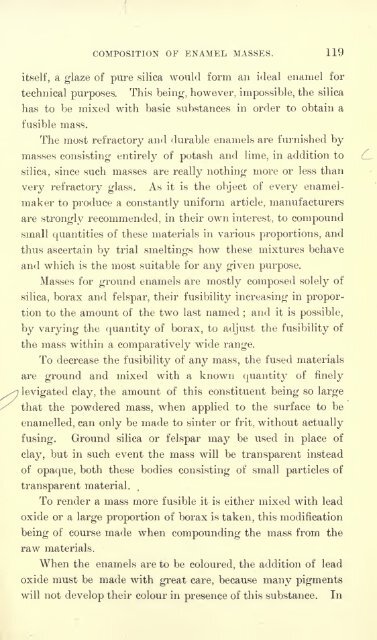Enamels and enamelling; an introduction to the preparation and ...
Enamels and enamelling; an introduction to the preparation and ...
Enamels and enamelling; an introduction to the preparation and ...
You also want an ePaper? Increase the reach of your titles
YUMPU automatically turns print PDFs into web optimized ePapers that Google loves.
COMPOSITION OF ENAMEL MASSES. 119<br />
itself, a glaze of pure silica would form <strong>an</strong> ideal enamel for<br />
technical purposes. This being, however, impossible, <strong>the</strong> silica<br />
has <strong>to</strong> be mixed with basic subst<strong>an</strong>ces in order <strong>to</strong> obtain a<br />
fusible mass.<br />
The most refrac<strong>to</strong>ry <strong><strong>an</strong>d</strong> durable enamels are furnished by<br />
masses consisting entirely of potash <strong><strong>an</strong>d</strong> lime, in addition <strong>to</strong><br />
silica, since such masses are really nothing more or less th<strong>an</strong><br />
very refrac<strong>to</strong>ry glass. As it is <strong>the</strong> object of every enamel -<br />
maker <strong>to</strong> produce a const<strong>an</strong>tly uniform article, m<strong>an</strong>ufacturers<br />
are strongly recommended, in <strong>the</strong>ir own interest, <strong>to</strong> compound<br />
small qu<strong>an</strong>tities of <strong>the</strong>se materials in various proportions, <strong><strong>an</strong>d</strong><br />
thus ascertain by trial smeltings how <strong>the</strong>se mixtures behave<br />
<strong><strong>an</strong>d</strong> which is <strong>the</strong> most suitable for <strong>an</strong>y given purpose.<br />
Masses for ground enamels are mostly composed solely of<br />
silica, borax <strong><strong>an</strong>d</strong> felspar, <strong>the</strong>ir fusibility increasing in proportion<br />
<strong>to</strong> <strong>the</strong> amount of <strong>the</strong> two last named ; <strong><strong>an</strong>d</strong> it is possible,<br />
by varying <strong>the</strong> qu<strong>an</strong>tity of borax, <strong>to</strong> adjust <strong>the</strong> fusibility of<br />
<strong>the</strong> mass within a comparatively wide r<strong>an</strong>ge.<br />
To decrease <strong>the</strong> fusibility of <strong>an</strong>y mass, <strong>the</strong> fused materials<br />
are ground <strong><strong>an</strong>d</strong> mixed with a known qu<strong>an</strong>tity of finely<br />
levigated clay, <strong>the</strong> amount of this constituent being so large<br />
that <strong>the</strong> powdered mass, when applied <strong>to</strong> <strong>the</strong> surface <strong>to</strong> be<br />
enamelled, c<strong>an</strong> only be made <strong>to</strong> sinter or frit, without actually<br />
fusing. Ground silica or felspar may be used in place of<br />
clay, but in such event <strong>the</strong> mass will be tr<strong>an</strong>sparent instead<br />
of opaque, both <strong>the</strong>se bodies consisting of small particles of<br />
tr<strong>an</strong>sparent material.<br />
To render a mass more fusible it is ei<strong>the</strong>r mixed with lead<br />
oxide or a large proportion of borax is taken, this modification<br />
being of course made when compounding <strong>the</strong> mass from <strong>the</strong><br />
raw materials.<br />
When <strong>the</strong> enamels are <strong>to</strong> be coloured, <strong>the</strong> addition of lead<br />
oxide must be made with great care, because m<strong>an</strong>y pigments<br />
will not develop <strong>the</strong>ir colour in presence of this subst<strong>an</strong>ce. In
















